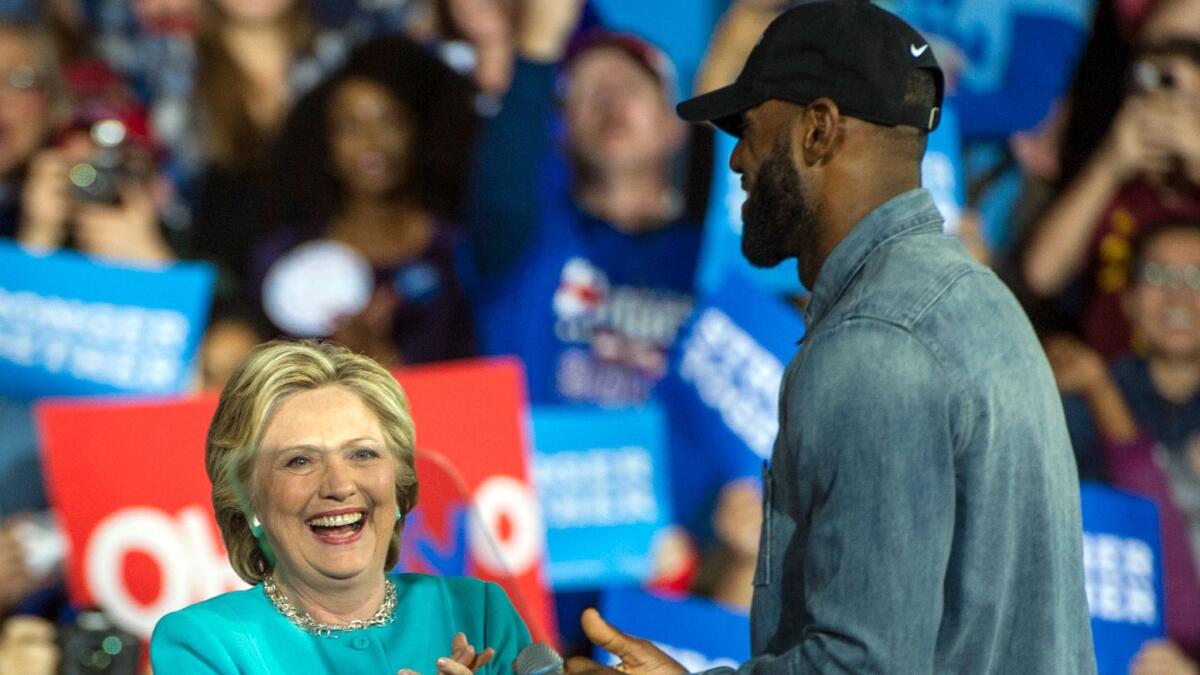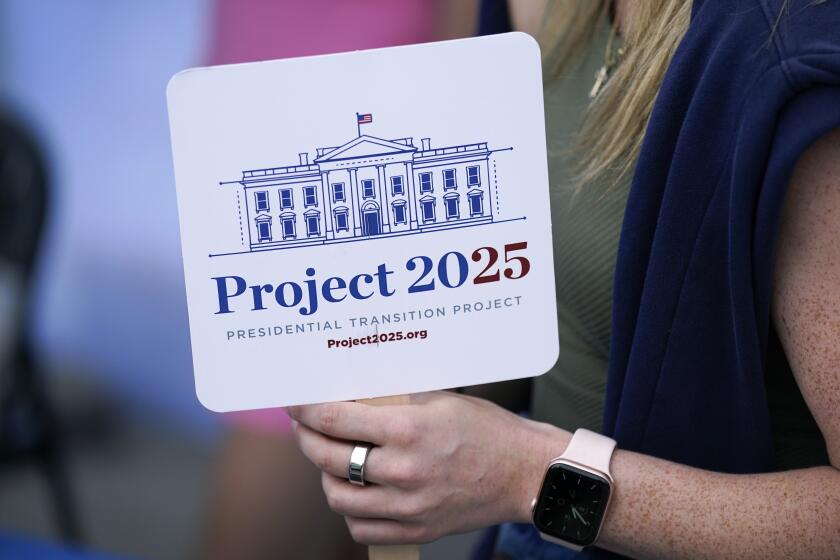The fight for Ohio pits a well-oiled Democratic machine against Republican enthusiasm

- Share via
Reporting from Columbus, Ohio — The ferocious fight for Ohio, a perennial presidential toss-up state, has come down to the machines: one well-practiced at maximizing votes, enthusiastic or not, and a second counting on ardent supporters to offset flaws in a less predictable operation.
Ohio in the closing days of the campaign presents one of the clearest tests nationally of a key difference between the Republican and Democratic efforts: Hillary Clinton has massed thousands of volunteers to move voters to the polls early and to get out the vote Tuesday. She has her enthusiastic fans here, to be sure, but has buttressed that with an organization built on President Obama’s two statewide victories.
Election 2016 | Live coverage on Trail Guide | Sign up for the newsletter
Donald Trump’s campaign, still suffering from its spats with the Republican governor and the state GOP party chief, is depending on a voter effort run by the Republican National Committee. It is trying to draw out voters for all of the state’s races, not just Trump’s — a circumstance that sometimes muddles the voter targeting that will be key to the outcome.
Complicating things further, each candidate is making a run at voters who would logically be the other’s. Clinton is hitting up suburban voters, mostly women, who usually side with Republicans and has aimed substantial advertising their way. Trump, in less visible fashion, is going after white, blue-collar voters who usually help propel Democratic candidates.
Those diametrically opposite appeals are playing out in a place in which the last four presidential contests have been decided by fewer than 5 percentage points each.
“We’re going to have a test of organization against enthusiasm,” said John C. Green, a veteran Ohio election expert and political science professor at the University of Akron.
As election day neared, each side was trying to shore up deficiencies, real or feared.
Clinton campaigned in the state Friday night and Sunday, seeking to drive up voting among African American and young voters, particularly in Cuyahoga County, where Cleveland is located and where a massive number of Democratic votes usually offsets Republican gains elsewhere.
She brought in performers Beyonce and Jay Z and Cavaliers’ star LeBron James to exhort their fans to cast ballots. James on Sunday acknowledged the temptation not to vote, but added that “it really does, it really, really does” matter.
Trump appeared in southwestern Ohio on Friday, and on Monday sent in Sarah Palin, the 2008 vice presidential nominee and conservative favorite, to drive up Republican votes.
The schedule underscored a rarity here: the absence of the candidates on the final campaign day. Ohio looked on forlornly Monday as the candidates careened elsewhere, into North Carolina and Pennsylvania and Florida and New Hampshire.
Those states are not necessarily closer contests but represent more substantial choke-points, particularly for Clinton as she seeks to deny Trump several paths to the presidency. While no Republican has ever won the White House without Ohio, Clinton can afford to lose the state as long as she wins the battlegrounds in which she was spending time Monday.
In early voting, Republican and Democratic counties in Ohio both reported increases in turnout compared with 2012. But it was not completely clear how much each candidate was poised to benefit.
This year, Democratic boosts in some areas of the state could mean more Trump supporters; Republican supporters in others could deliver an advantage for Clinton. Both sides expressed confidence in their own campaign and candidate.
Clinton’s state campaign director, Chris Wyant, said that increases in the ranks of early voters were “a reflection of both the organization we’ve built and the enthusiasm voters have for Hillary Clinton.”
Even in areas like Cuyahoga County, the campaign ultimately will corral its voters, he said.
“If they have yet to vote, they’ll vote tomorrow,” he said Monday. He noted that even in the Cleveland area, the rate of early voting increased in recent days.
Trump campaign officials in Ohio referred questions to the RNC, whose field director, Chris Young, expressed confidence in the outcome.
“The infrastructure we put on the ground in Ohio is the strongest ground game we’ve ever put together in that state,” Young said during a telephone conference with reporters.
But the Republican influx of hundreds of paid staff and trained volunteers has been offset by regular displays of party disunity.
The seeds were sown when Ohio Gov. John Kasich ran against Trump and proved to be one of the last two survivors in an unruly field. Unlike most of the defeated candidates, he refused to endorse Trump despite pressure from national Republicans.
Kasich did not appear at the summer convention, held in Cleveland — a stinging slap at a party nominee by the home-state governor. He has regularly been critical of Trump, who he said in a recent statement “has behaved in a manner that reflects so poorly on our country.”
The governor has traveled the country this general election season raising money for other Republicans, in what is widely seen as an effort to create alliances for another presidential run in the future. A week ago, in a well-publicized gesture, he cast his 2016 ballot by writing in the name of Arizona Sen. John McCain.
Matt Borges, the state party chief who is allied with Kasich, has been openly critical of Trump in recent months, an effort that his colleagues say was intended to curb Trump’s more outlandish behavior.
Although Borges ultimately said he would vote for the party’s nominee, Trump’s campaign took a shot at him, accusing him of “duplicity” in a letter to state party committee members that swiftly became public.
Trump does have one powerful Republican ally in the state, even if he’s so far declined to campaign with the nominee: Sen. Rob Portman.
Republican Senate candidates across the country have been locked in tight races, but Portman is the exception, enjoying what appears to be a glide path to easy reelection against the Democratic nominee, former Gov. Ted Strickland.
One Republican official, who declined to be identified comparing the campaigns, said that Portman’s well-organized operation “has undoubtedly helped Donald Trump’s effort in the state” by drawing in voters the presidential candidate’s campaign can’t otherwise reach.
But it invariably comes back to the presidential candidates and the odd division of voters between them this year.
The state lacks a substantial Latino population of the sort that has given Clinton a boost in some other states and has offset the early slump in African American votes. That has left the outcome uncertain as election day dawned.
“The election is very close, but the alignment of voters in the polls and when votes are cast is different,” Green said. “We may see a scrambling of previous coalitions.”
Twitter: @cathleendecker
ALSO:
Win or lose Tuesday, Democrats face a fight to define themselves
Can Clinton or Trump put a fractured nation back together?
Updates on California politics
Live coverage from the campaign trail
More to Read
Get the L.A. Times Politics newsletter
Deeply reported insights into legislation, politics and policy from Sacramento, Washington and beyond. In your inbox twice per week.
You may occasionally receive promotional content from the Los Angeles Times.











